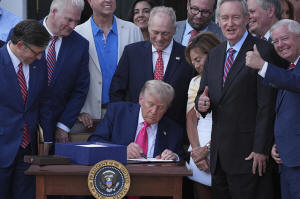What Trump's big tax law could mean for the youngest Americans
[July 09, 2025]
By MORIAH BALINGIT
WASHINGTON (AP) — The impact of the massive spending bill that President
Donald Trump signed into law on Independence Day is expected to filter
down to infants and toddlers — a segment of the population that is
particularly vulnerable to cuts to the federal social safety net.
Many middle-class and wealthy families will see benefits from the new
legislation, but programs that help low-income families keep babies
healthy have been cut back. While state money funds public schools and
preschool in some cases, programs supporting the youngest children are
largely backed by the federal government.
The law extends tax cuts that Trump passed during his first term in
office and pours billions more into border security as the president
seeks to broaden his crackdown on immigration. To pay for these
initiatives, the law cuts Medicaid and food stamps — programs relied
upon by poor households with children — by more than $1 trillion.
The legislation Republicans called Trump's “big beautiful bill" is set
to deliver some gains for families with children. It increases tax
credits, including one that now allows parents to deduct up to $2,200
per child from their tax bills. And it introduces investment accounts
for newborns dubbed “Trump Accounts,” each seeded with $1,000 from the
government.
Still, advocates say they do not make up for what children are likely to
lose under the new law. And they fear what comes next, as the next Trump
budget proposes more cuts to programs that help parents and babies.

Medicaid cuts could add to strains on families
Over 10 million Americans rely on Medicaid for health care. About 40% of
births are covered by Medicaid. Newborns, too, qualify for it when their
mothers have it.
The new law doesn't take little kids or their parents off Medicaid. It
institutes Medicaid work requirements for childless adults and adults
with children over the age of 13. But pediatricians warn the cuts will
be felt broadly, even by those who do not use Medicaid.
The Medicaid cuts are expected to put a financial strain on health care
providers, forcing them to cut their least profitable services. That’s
often pediatrics, where young patients are more likely to use Medicaid,
said Lisa Costello, a West Virginia pediatrician who chairs the federal
policy committee for the American Association of Pediatrics.
The ripple effects could exacerbate an existing shortage of
pediatricians and hospital beds for children.
“Any cuts to that program are going to trickle down and impact children,
whether that’s pediatric practices who depend on Medicaid to be able to
stay open or children’s hospitals,” Costello said.
States also use Medicaid to pay for programs that go beyond conventional
medical care, including therapies for young children with disabilities.
Under the new law, states will foot a greater portion of the bill for
Medicaid, meaning optional programs are at risk of getting cut.

Advocates worry that if an adult loses Medicaid coverage, it could
ratchet up household stress and make it more difficult for parents to
make ends meet, both of which can negatively impact youngsters. And
parents who lose their health insurance are less likely to take their
children to the doctor.
“When parents lose their health insurance, they often think that their
children also are no longer eligible, even if that’s not the case,” said
Cynthia Osborne, a professor of early education and the executive
director of the Prenatal-to-3 Policy Impact Center at Vanderbilt
University.
[to top of second column]
|

President Donald Trump signs his signature bill of tax breaks and
spending cuts at the White House, Friday, July 4, 2025, in
Washington, surrounded by members of Congress. (AP Photo/Evan Vucci)

The law increases tax credits for parents who qualify
The law increases the child tax credit to $2,200 per child, up from
$2,000. But parents who don’t earn enough to pay income tax will
still not see the benefit, and many will only see a partial benefit.
The measure also contains two provisions intended to help families
pay for child care, which in many places costs more than a mortgage.
First, it boosts the tax credit parents receive for spending money
on child care. The bill also expands a program that gives companies
tax credits for providing child care for their employees.
Both measures have faced criticism for generally benefiting larger
companies and wealthier households.
“It’s a corporate business tax break,” said Bruce Lesley, president
of the advocacy group First Focus on Children. “It makes their child
care dependent upon working for an employer who has the credit.”
‘Trump Accounts’ will be opened with $1,000 for newborns
The law launches a program that creates investment accounts for
newborn children. The “Trump Accounts” are to be seeded with $1,000
from the government, and children will be able to use the money when
they become adults to start a new business, put the money toward a
house or go to school.
Unlike other baby bond programs, which generally target
disadvantaged groups, the federal program will be available to
families of all incomes.
The program's backers have pitched the accounts as a way to give
young people a boost as they reach adulthood and teach them about
the benefits of investing. Critics have argued that families in
poverty have more immediate needs and that their children should
receive a larger endowment if the goal is to help level the playing
field.

A food assistance program faces cuts
The Supplemental Nutrition Assistance Program (SNAP) faces the
largest cut in its history under the law. It will, for the first
time, require parents to work to qualify for the benefit if their
children are 14 or older. But even households with younger children
could feel the impact.
The law kicks some immigrants — including those with legal status —
off food assistance. It makes it more difficult for individuals to
qualify by changing how it considers their utility bills.
SNAP has historically been funded by the federal government, but
under the new law, states will have to shoulder some of the
financial burden. Cash-strapped governments could decide to
implement new requirements that would make it more difficult for
people to qualify, said Katie Bergh, a senior policy analyst with
the Center on Budget and Policy Priorities. Some states may decide
to exit the program altogether.
“When young children lose access to that healthy nutrition, it
impacts them for the rest of their lives,” Bergh said. “This bill
fundamentally walks away from a long-standing nationwide commitment
to making sure that low-income children in every state can receive
the food assistance that they need."
All contents © copyright 2025 Associated Press. All rights reserved |